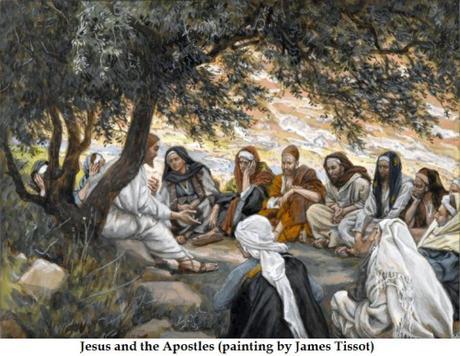Acts 5:27-32, 40-41
When the captain and the court officers had brought the apostles in
and made them stand before the Sanhedrin,
the high priest questioned them,
“We gave you strict orders, did we not,
to stop teaching in that name?
Yet you have filled Jerusalem with your teaching
and want to bring this man’s blood upon us.”
But Peter and the apostles said in reply,
“We must obey God rather than men.
The God of our ancestors raised Jesus,
though you had him killed by hanging him on a tree.
God exalted him at his right hand as leader and savior
to grant Israel repentance and forgiveness of sins.
We are witnesses of these things,
as is the Holy Spirit whom God has given to those who obey him.”
The Sanhedrin ordered the apostles
to stop speaking in the name of Jesus, and dismissed them.
So they left the presence of the Sanhedrin,
rejoicing that they had been found worthy
to suffer dishonor for the sake of the name.

Some years ago, I took a graduate-level course on “Modern Christology” at a prestigious Catholic school of philosophy and theology.
The word “ology” comes from the Greek word “logos,” which means the “study of” something. Simply put, Christology is the systematic study of Jesus Christ.
Modern Christology is a product of the Enlightenment. Unlike Medieval Christology that presumed Jesus is the Christ, Modern Christology studies Jesus “as a figure in history”: Was there a man named Jesus? Did he actually live?
In the course of the semester, I learned two main pieces of facts:
- A few historians of the time, e.g., Josephus, made references to Jesus but, other than confirming there was a person named Jesus (or Yeshu) who had inspired followers who then called themselves Christians, the information these historians gave is extremely sketchy.
- There are reasons to doubt the Gospels were contemporaneous accounts of Jesus or that they had been written by His apostles.
At the end of the course, I concluded that the quest for “the historical Jesus” is to be found in historical accounts of the Apostles — the percipient witnesses. It is there—in the Apostles’ behaviors, lives, and deaths—that I found the most compelling testimony of not just the historical Jesus the man, but Jesus the Christ.
This is what we know about the Apostles:
- All the Apostles, except the youngest named John, abandoned Jesus after He was taken away from the Garden of Gethsemane by Roman soldiers.
- The apostle Simon Peter—on whom Jesus founded and to whom he entrusted his Church—thrice denied he even knew Jesus.
- The Apostles were understandably frightened by Jesus’ crucifixion, which was the Roman Empire’s cruelest form of execution reserved for the worst criminals. They were so frightened that they went into hiding.
- On the third day after Jesus died, His body disappeared from the tomb.
- After that, the Apostles became completely transformed: from cowering to being fearless; from illiterate fishermen to bold preachers of good tidings (the gospel) to crowds of strangers—and in different languages !; from having abandoned their master and teacher to die alone on the cross, to become martyrs. Simon Peter, for example, who had thrice denied even knowing Jesus, was martyred in 64 A.D. in Rome under Emperor Nero Augustus Caesar, by being crucified upside down at his own request, because he saw himself unworthy to be crucified in the same way as his master.
Such a total transformation can only be accounted for and explained by something extraordinary that happened in that brief interim between the crucifixion of Jesus and the disappearance of His body. What happened had to be something even more extraordinary than the miracles the Apostles had witnessed in the three years of Jesus’ public ministry. Those miracles included:
- The multiplication of a few fishes and loaves to feed thousands;
- The healing of the blind, the lame, and the sick;
- The casting of demons from the possessed;
- Jesus walking on water;
- Jesus calming a stormy sea;
- Jesus reattaching the severed ear of a Roman soldier in Gethsemane;
- Jesus raising Lazarus from the dead….
That super-extraordinary event was the Resurrection.
Only the risen Christ could have so convinced sane, rational men as to completely and quickly transform them into believers in the Resurrection. Only by seeing the risen Christ — by speaking, walking, and eating with the risen Christ, and in the case of doubting Thomas, by touching the very wounds of the risen Christ — could the Apostles have changed overnight from being frightened little rabbits into fearless outspoken men whom no one could silence and who each went, willingly and joyfully, to a martyr’s death for their risen Lord.
And so, in the end, the quest for the historical Jesus remains elusive, but the quest for the Christ Jesus is in the personal testimonies of the lives of the Apostles. As C. S. Lewis once wrote:
“Men are mirrors, or ‘carriers’ of Christ to other men. Usually it is those who know Him who bring Him to others.”
To quote theologian-Christologist Mark Allan Powell (Jesus As a Figure in History, p. 9):
“[F]or me…the Jesus of this story has come to mean more than knowing history. Over the years, it has come to mean recognizing the story to be grounded in the witness of the Spirit, in the testimonies of saints and martyrs, and in my own life experience…. I never once have felt as though I were finding Jesus in any of this, but I frequently feel as though I am being found. I think of the story…not as the place where I look for Jesus but as the place where he finds me.”
May the joy and peace and love of our Lord Jesus the Christ be with you!
~Eowyn

